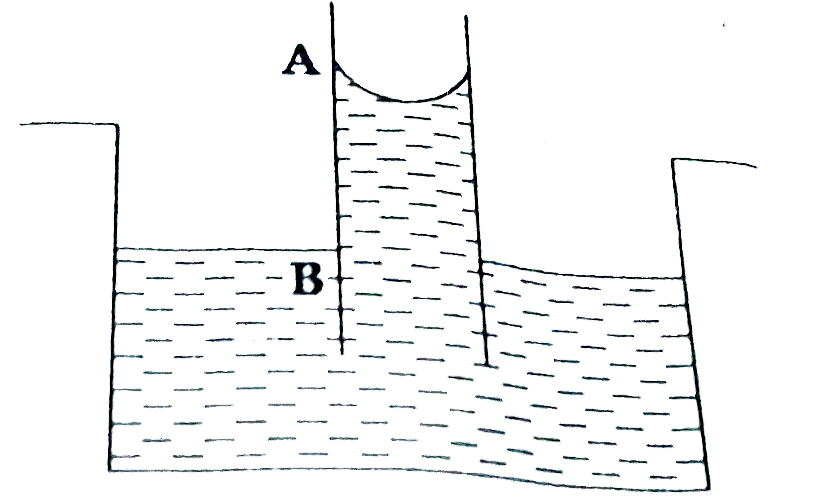A coaxial cylinder made of glass is immersed in a-liquid of surface tension S. The radius of the inner and outer surface of the cylinder are R1andR2 respectively . Height till which liquid will rise is (Density of liquid is ρ )
2SR2ρg
2SR1ρg
S(R2−R1)ρg
2S(R2−R1)ρg
The correct Answer is:D
To solve the problem of how high a liquid will rise in a coaxial cylinder made of glass immersed in a liquid with surface tension S, we can follow these steps:
Step 1: Understand the Forces Acting on the Liquid
The liquid inside the coaxial cylinder experiences two main forces:
- The upward force due to surface tension acting on the inner and outer surfaces of the cylinder.
- The downward force due to the weight of the liquid column.
Step 2: Calculate the Upward Force Due to Surface Tension
The upward force F due to surface tension can be calculated using the formula:
F=T⋅L
Where T is the surface tension S and L is the total length of the contact line. This includes both the inner and outer surfaces of the cylinder:
L=2πR1+2πR2
Thus, the total upward force becomes:
F=S⋅(2πR1+2πR2)
Step 3: Calculate the Weight of the Liquid Column
The weight W of the liquid column can be expressed as:
W=m⋅g
Where m is the mass of the liquid and g is the acceleration due to gravity. The mass m can be calculated using the density ρ of the liquid and the volume V of the liquid column:
m=ρ⋅V
The volume V of the liquid column is the difference between the outer cylinder volume and the inner cylinder volume:
V=π(R22−R21)⋅h
Thus, the weight becomes:
W=ρ⋅π(R22−R21)⋅h⋅g
Step 4: Set Up the Equation for Equilibrium
At equilibrium, the upward force due to surface tension equals the downward weight of the liquid:
S⋅(2πR1+2πR2)=ρ⋅π(R22−R21)⋅h⋅g
Step 5: Simplify the Equation
We can cancel π from both sides:
S⋅(2(R1+R2))=ρ⋅(R22−R21)⋅h⋅g
Step 6: Solve for Height h
Rearranging the equation to solve for h:
h=2S(R1+R2)ρ(R22−R21)g
Final Formula
Thus, the height h to which the liquid will rise in the coaxial cylinder is given by:
h=2S(R1+R2)ρ(R22−R21)g
The liquid inside the coaxial cylinder experiences two main forces:
- The upward force due to surface tension acting on the inner and outer surfaces of the cylinder.
- The downward force due to the weight of the liquid column.
The upward force F due to surface tension can be calculated using the formula:
F=T⋅L
Where T is the surface tension S and L is the total length of the contact line. This includes both the inner and outer surfaces of the cylinder:
L=2πR1+2πR2
Thus, the total upward force becomes:
F=S⋅(2πR1+2πR2)
The weight W of the liquid column can be expressed as:
W=m⋅g
Where m is the mass of the liquid and g is the acceleration due to gravity. The mass m can be calculated using the density ρ of the liquid and the volume V of the liquid column:
m=ρ⋅V
The volume V of the liquid column is the difference between the outer cylinder volume and the inner cylinder volume:
V=π(R22−R21)⋅h
Thus, the weight becomes:
W=ρ⋅π(R22−R21)⋅h⋅g
At equilibrium, the upward force due to surface tension equals the downward weight of the liquid:
S⋅(2πR1+2πR2)=ρ⋅π(R22−R21)⋅h⋅g
We can cancel π from both sides:
S⋅(2(R1+R2))=ρ⋅(R22−R21)⋅h⋅g
Rearranging the equation to solve for h:
h=2S(R1+R2)ρ(R22−R21)g
Thus, the height h to which the liquid will rise in the coaxial cylinder is given by:
h=2S(R1+R2)ρ(R22−R21)g
Topper's Solved these Questions
Similar Questions
If the time period (T)of vibration of a liquid drop depends on surface tension (S) , radius(r) of the drop , and density (ρ) of the liquid , then find the expression of T.
View SolutionWhen a capillary tube of radius r is dipped vertically in a liquid of surface tension T, the liquid rises to a height h in the tube above the level outside the tube . If the angle of contact is θ the density of the liquid is ρ then the pressure difference between the points A and B is

View Solution
Knowledge Check
Internal pressure inside a liquid drop of radius r and surface tension T is
A2Tr−P0B4Tr+P0CP0+2TrDT4r−P0A needle of length l and density ρ will float on a liquid of surface tension σ if its radius r is less than or equal to:
A√2σπρlgB√2σlπρgC√σπρgD√2σπρgA disc of radius R has a concentric hole of radius r. It is floating on a liquid of surface tension T . What is the force of surface tension on the disc ?
A4π(R+r)TB4π(R−r)TC2π(R−r)TD2π(R+r)T
A vertical U-tube contains a liquid of densityρ and surface tension T. if the radius of the meniscus of liquid in the limbs of the U-tube are R1 and R2 find the difference in the liquid column in the limbs.
View SolutionA capillary tube of radius r is lowered into a liquid of surface tension T and density ρ. Given angle of contact =0∘.
The work done by surface tension will be
View SolutionA triangular lamina of area A and height h is immersed in a liquid of density ρ in a vertical plane with its base on the surface of the liquid. The thrust on the lamina is.
View SolutionThe potential energy of the liquid of surface tension T and density ρ that rises into the capillary tube is
View SolutionA capillary tube with inner cross-section in the form of a square of side a is dipped vertically in a liquid of density ρ and surface tension ρ which wet the surface of capillary tube with angle of contact θ . The approximate height to which liquid will be raised in the tube is : (Neglect the effect of surface tension at the corners of capillary tube)
View Solution
